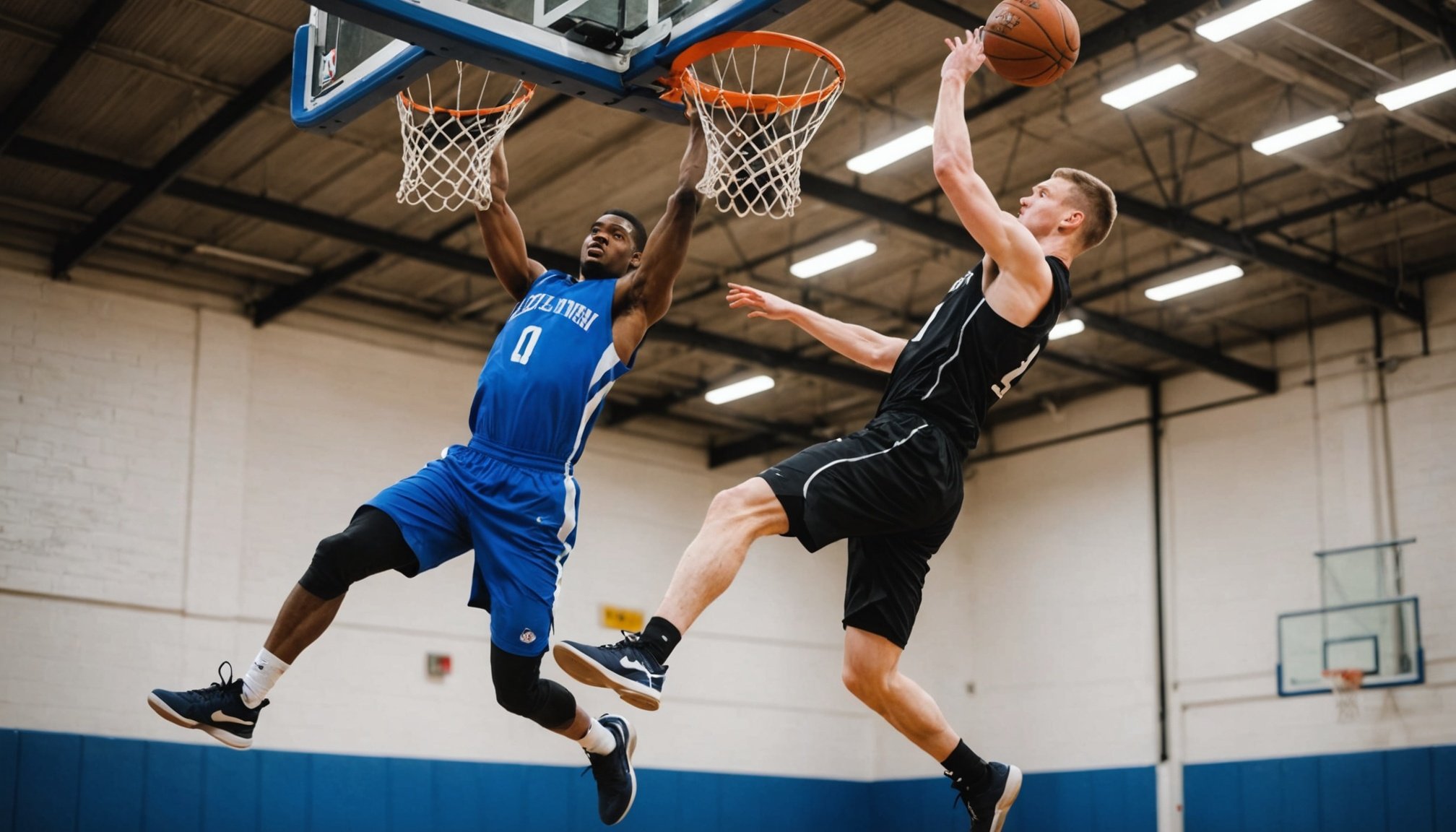Comprehensive Strength Training Program
To enhance athletic performance—specifically when it comes to basketball—strength training is instrumental. One significant benefit of a well-rounded routine is its ability to improve your vertical leap. A good jump contributes to powerful dunks and effective shot blocking, crucial in basketball training programs.
Understanding the components of a strength training program is vital. Start by focusing on the exercises’ core, such as squats, deadlifts, and calf raises. These workouts target essential muscle groups like the quadriceps, hamstrings, glutes, and calves, which are necessary for powerful jumps. Resistance bands and plyometric exercises can further aid in performance enhancement, offering you varied routines to engage different muscles and avoid monotony.
This might interest you : Maximize your game: the ultimate heart rate monitor guide for uk basketball players to boost training efficiency
Achieving progression in your workouts is paramount. Gradual increases in intensity, weight, or complexity can help challenge your body and lead to muscle adaptation, resulting in a stronger jump. Consistency is key—aim for strength training at least 2-3 times per week, ensuring adequate rest between sessions to allow muscle recovery.
By integrating strength training into your basketball regimen, not only can you enhance your vertical leap, but also experience overall improvements in speed, agility, and endurance on the court.
Also to discover : Maximizing performance potential: the essential role of strength and conditioning in training uk basketball athletes
Key Exercises for Elevating Vertical Leap
Developing a powerful vertical leap is crucial for athletes looking to enhance their performance. Through targeted vertical leap exercises, one can significantly increase their jumping ability.
Squats and Variations
Squats are foundational strength exercises for athletes aiming to boost lower body power. The benefits of squats include increased muscle mass and improved balance. Variations like jump squats and box squats are excellent, each providing distinct benefits. Jump squats involve explosive movements that promote agility and speed, while box squats focus on control and muscle endurance. For optimal results, athletes are encouraged to perform 3-4 sets of 8-12 repetitions per session, depending on their skill level and goals.
Plyometric Drills
Plyometric training focuses on quick, explosive movements that enhance muscle power. Incorporate box jumps and depth jumps into your regimen to improve explosiveness. Box jumps strengthen leg muscles, while depth jumps refine quickness and response times. It’s vital to incorporate plyometrics gradually into routines, ensuring exercises are performed correctly to avoid injury.
Core Strengthening Exercises
A strong core is indispensable for a vertical leap. Exercises like planks and medicine ball twists significantly aid core development. These workouts stabilize the body and enhance overall performance. Aim for consistent sessions, ideally three times a week, to build and maintain core strength adequately.
Nutritional Guidelines for Performance
In the realm of athletic nutrition, maintaining a diet that caters to the rigorous demands of basketball is crucial for amplifying performance. Proper nutrition isn’t just about energy; it’s about optimizing strength and recovery to ensure athletes stay at the top of their game.
For basketball athletes, a diet rich in both macronutrients and micronutrients is imperative. Macronutrients, including carbohydrates, proteins, and fats, serve as the primary energy source and are essential for muscle repair and growth. Meanwhile, micronutrients such as vitamins and minerals play a pivotal role in sustaining peak performance levels, aiding in everything from bone health to reducing fatigue.
Consider integrating performance-enhancing meals with a focus on balanced nutrients. For instance, a breakfast might include oatmeal topped with fresh berries and a dollop of Greek yogurt – a delightful mix that offers carbs for energy and protein for muscle sustenance. For lunch, grilled chicken with quinoa and roasted vegetables provides a robust blend of nutrients, essential for recovery post-training.
Sample meal plans, specifically tailored for basketball athletes in the UK, often emphasize local produce and lean proteins, ensuring accessibility and sustainability. This approach not only supports individual athlete needs but also aligns with broader dietary guidelines designed to enhance athletic capabilities.
Performance Tracking and Progress Monitoring
Keeping track of your workout performance is crucial for effective progress measurement. By tracing improvements over time, you ensure that your efforts are effectively contributing to your goals. Setting up an efficient system for performance tracking includes using reliable tools and apps.
Methods for Tracking Progress
Monitoring your physical improvements is vital for appreciating your journey and adjusting your objectives. Engage with recommended tools and apps tailored for workout tracking. Look for features that detail each workout, provide insights, and suggest enhancements. It’s essential to set realistic benchmarks to motivate yourself without risking injury.
Assessment Techniques for Vertical Jump
Measuring your vertical leap can significantly inform your training processes. Implement different methods such as jump mats and Vertec to gain a precise assessment. Conduct these assessments regularly to track progressive improvement. Interpreting the results accurately can aid in appropriately adjusting your training routines.
Utilizing Feedback for Training Improvement
Feedback, whether from a coach, trainer, or through self-assessment, enriches the training experience. Cultivating self-awareness allows you to self-assess regularly and integrate those insights into your routine. Peer support and training groups offer unique perspectives and communal encouragement, which can further enhance your overall performance tracking and success in athletic endeavors.
Common Challenges and Solutions
Vertical leap training demands dedication, but athletes often face common challenges. Understanding these obstacles is essential to develop effective strategies tailored to overcoming training obstacles. Performance issues may arise due to physical plateaus or psychological barriers, which can hinder progress.
Athletes frequently encounter plateaus during training, where improvements stagnate despite continuous effort. To tackle this, incorporating varied approaches like plyometric exercises and strength training can break static phases. Another hurdle is dealing with injuries; ensuring proper technique and conditioning helps mitigate risks. Rest and rehabilitation are crucial to recovery while also avoiding further complications.
Sports psychology plays a pivotal role in enhancing an athlete’s mental resilience. Techniques such as visualization and positive self-talk can significantly improve focus and determination. These mental strategies empower athletes to push through mental blocks and maintain consistent performance levels.
Additionally, regular assessments can provide insights into potential weaknesses or areas needing improvement, ensuring a holistic approach to progressing beyond limitations. Setting realistic goals and continued learning are vital to overcoming these setbacks.
By recognizing these common challenges and implementing tailored solutions, athletes can advance in their training and achieve greater vertical leap heights.
Testimonials and Case Studies from UK Athletes
UK athletes have been instrumental in sharing success stories about their training, especially focusing on enhancing vertical leap. By looking at these achievements, we get a peek into how tailored training routines have transformed their athletic performance.
Take, for example, UK basketball star Amy Thompson, who improved her game significantly after adopting a specialized program aimed at boosting her vertical leap. Her case study illustrates the importance of specific exercises such as plyometrics and resistance training. These methods not only enhanced her jump height but also improved her overall performance on the court.
Case studies from other athletes reveal similar patterns. Sam Carter, a young basketball enthusiast, credits his leap training for his exceptional rise in UK basketball performance, emphasizing consistency and dedication as key elements. Training routines involving squats, jump ropes, and flexibility exercises were central to his progress.
These stories highlight the impact of well-structured training regimens. UK athletes consistently report significant improvements, underscoring the value of tailored training programs. Their testimonials provide both insights and inspiration, demonstrating that with the right approach, achieving enhanced athletic performance is within reach.











